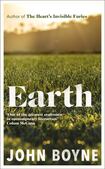
Earth is the second instalment in John Boyne’s ambitious project of four interconnected novellas tackling the subject of abuse from varying perspectives. The concept of four books, each named after one of the four elements and released at six-month intervals, is both artistically appealing and a stroke of marketing genius.
Last year’s Water told the story of a woman who had fled to an island after her husband was arrested for sexually abusing young girls. This second instalment takes a minor character from that island, Evan, and picks up his story a few years on.
Evan is now living in England and working as a highly paid professional footballer. He and a team-mate, Robbie, are defendants in a high-profile rape trial (Evan filmed the sexual encounter in question on his phone, which is now conveniently missing).
Earth feels much darker than its predecessor because while the abuse in Water happened off the page, here we encounter many different forms of abuse head-on. While the court case deals with the more obvious abuse of rape, Boyne uses Evan’s relationship with his father to explore more subtle forms of abuse like the emotional impact of parental rejection.
Evan is gay and wants to be an artist but his father likes football and withholds all affection and love from his son. As with Water, shame is the overriding theme and Boyne shows us how insidious shame can be, threading it through every element of his story from sex to class to identity.
While the books are slim and readable – I read both in one sitting – the stories are packed with big ideas, moral questions and social commentary on everything from how easily we judge women for their sexual histories to how we treat young boys and how that influences the men those boys become. In other words they are perfect book club selections – modest in size but vast in discussion points.
Boyne is clearly not a writer happy to rest on his past achievements, which include the million-selling novels The Heart’s Invisible Furies and The Boy In The Striped Pyjamas and the decision to try something new and ambitious is admirable.
The big pay-off for the reader will come when all four books are published, and we can go back to the start and enjoy all facets of the story a second time through the prism of the completed quartet.
















